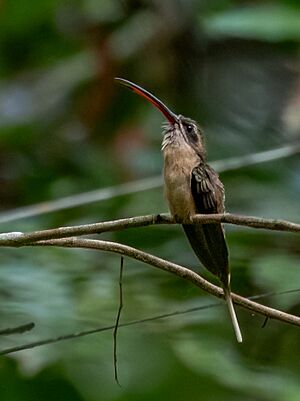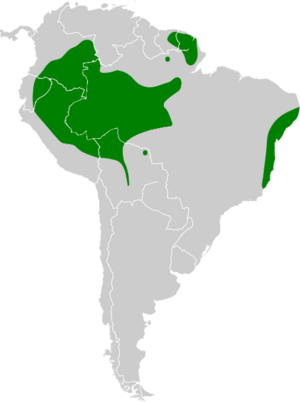Great-billed hermit facts for kids
Quick facts for kids Great-billed hermit |
|
|---|---|
 |
|
| Conservation status | |
| Scientific classification | |
| Genus: |
Phaethornis
|
| Species: |
malaris
|
 |
|
The great-billed hermit (Phaethornis malaris) is a type of hummingbird. These tiny birds are known for their long, curved beaks and quick movements. You can find them in parts of South America, including Bolivia, Brazil, Colombia, Ecuador, French Guiana, Peru, Suriname, and Venezuela.
Contents
How Scientists Classify Them
The way scientists group the great-billed hermit can be a bit tricky. In the past, some similar hummingbirds were thought to be the same species. Now, they are often seen as different. Even today, some experts are still working to fully understand how all these related hummingbirds fit together.
Different Kinds of Great-billed Hermits
There are usually six recognized types, or subspecies, of the great-billed hermit. Think of subspecies as slightly different versions of the same animal, often found in different places. Here are the main ones:
- P. m. malaris
- P. m. insolitus
- P. m. moorei
- P. m. ochraceiventris
- P. m. bolivianus
- P. m. margarettae
Sometimes, P. m. margarettae is even considered its own separate species. Other subspecies might also be split off in the future.
What Does It Look Like?
The great-billed hermit is a medium-sized hummingbird. It measures about 13 to 17.5 cm (5.1 to 6.9 in) long. Males are a bit heavier, weighing 4.5 to 10 g (0.16 to 0.35 oz), while females weigh 4 to 8 g (0.14 to 0.28 oz).
This bird has greenish-brown feathers on its back and brownish to grayish feathers on its belly. The feathers near its tail have dark and light bands. Its two central tail feathers are long and have white tips. It has a long, curved beak. The female's beak is usually shorter but more curved than the male's.
How Subspecies Are Different
Different subspecies have slight variations in their appearance:
- The P. m. malaris subspecies is the largest.
- P. m. insolitus is smaller but looks similar to P. m. malaris.
- P. m. moorei has lighter, grayer feathers on its belly.
- P. m. bolivianus and P. m. margarettae are the smallest. P. m. bolivianus has a dark brown throat and chest, with an orange belly. P. m. margarettae is very similar but has paler belly feathers.
- P. m. ochraceiventris stands out with a bright orange chest and belly.
Where Does It Live?
The great-billed hermit lives in various parts of South America. Each subspecies is found in specific regions:
- P. m. malaris lives in Suriname, French Guiana, and northern Brazil.
- P. m. insolitus is found in eastern Colombia, southern Venezuela, and northwestern Brazil.
- P. m. moorei ranges from eastern and southern Colombia, through eastern Ecuador, into northeastern Peru.
- P. m. ochraceiventris lives in northeastern Peru and western Brazil.
- P. m. bolivianus is found in southeastern Peru, central Bolivia, and western Brazil.
- P. m. margarettae lives along the coast of eastern Brazil.
Its Home in the Forest
These hummingbirds prefer to live in the lower parts of different kinds of rainforests. This includes forests on solid ground, in foothills, and at higher elevations. They also live in areas where the forest is changing, in younger forests that have grown back, and in bamboo patches. One subspecies, P. m. ochraceiventris, also lives in flooded forests.
They usually live below 600 m (2,000 ft) in elevation. However, you can find them higher up in some places, like 1,500 m (4,900 ft) in Colombia and 2,400 m (7,900 ft) in Bolivia.
How It Lives
What Do They Eat?
Like other hermit hummingbirds, the great-billed hermit is a "trap-line" feeder. This means it flies a regular route, visiting many different flowering plants to drink their nectar. Some of its favorite flowers include Heliconia and Pitcairnia. Besides nectar, it also eats small arthropods, like tiny insects or spiders.
Reproduction and Nests
The breeding season for the great-billed hermit changes depending on where they live. For example, in French Guiana, they breed from August to December. In Bolivia, it's from June to September, and in Peru, from June to November.
Like most hermit hummingbirds, they build a cone-shaped nest. They make it from plant fibers and spider silk. The nest hangs from the underside of a drooping leaf, keeping it safe and hidden. A female usually lays two eggs.
What Does It Sound Like?
The great-billed hermit's song is a continuous series of notes that rise and fall, often sounding like "slee-up." The exact sound can be a bit different among the various subspecies. They also make a sharp "skweep!" call, especially when they are flying.
Is It Safe?
The IUCN (International Union for Conservation of Nature) has listed the great-billed hermit as a species of "Least Concern." This means that, for now, it is not considered to be in danger of disappearing. However, scientists don't know the exact number of these birds, and their population is thought to be decreasing.
One subspecies, P. m. margarettae, which lives in eastern Brazil, could be at risk. This is because its forest home is shrinking due to human activities.


